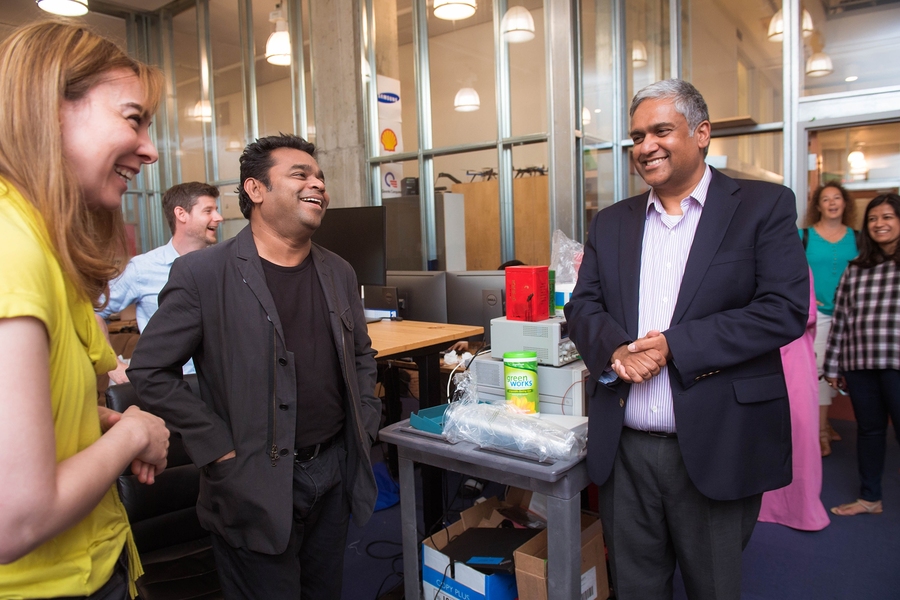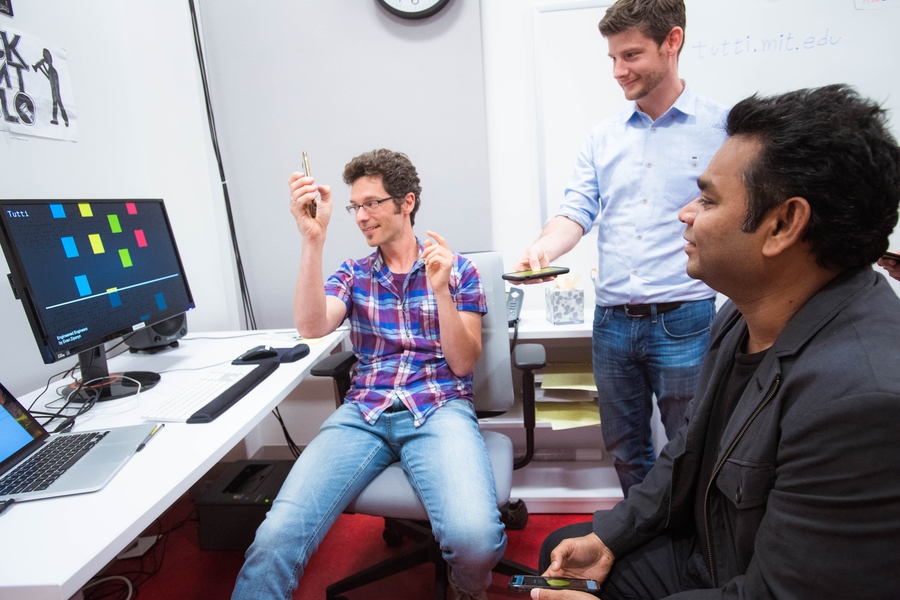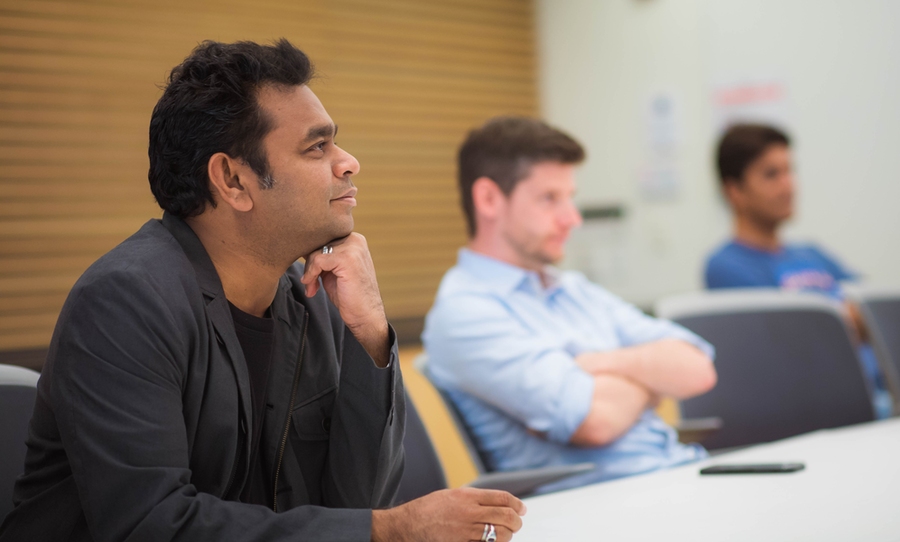When A. R. Rahman, two-time Academy Award winner, singer-songwriter, and music producer from India, came to visit and take a course at MIT in July, he was in his element during a tour of interactive music systems on campus.
Anantha Chandrakasan, dean of the School of Engineering, led Rahman and his group to Building 24 where the small group of mostly non-musicians jammed together using their smartphones to sound off as brass, clarinet, percussion, or strings.
Rahman tapped a sneakered foot to the beat. “This is fantastic,” says Rahman of the performance orchestrated by MIT professor of the practice Eran Egozy ’95, MEng ’95, who teaches, among other things, 21M.385 / 6.809 (Interactive Music Systems) — the first MIT music class that is also an electrical engineering and computer science class.
These creative points of convergence are exciting, says Chandrakasan, who is also the Vannevar Bush Professor of Electrical Engineering and Computer Science. “There are tremendous opportunities to bring computing and artificial intelligence, sensing, and other technological advances to the world of music,” he says.
Rahman’s own music is known to experiment with the fusion of traditional instruments with new electronic sounds and technology. Like Egozy, he is passionate about using technology to enhance the experience of listening to or making music and enabling people to engage with it.
“You created games about things that are constructive not destructive.” Rahman says with a nod of approval to Egozy, co-founder and chief scientist of the company that brought the world “Guitar Hero” and “Rock Band.”
A recipient of multiple Academy Awards, Rahman is especially interested in harnessing the power of technology in music to counter inequality, hate, and violence in social media and global discourse.
Music and technology for the next generation
Rahman was on a whirlwind MIT tour that involved visits with a string of creative academics in multiple realms: music, technology, artificial intelligence, machine learning, and robotics among them.
His visit capped off a week during which Rahman dove into a four-day course offered by MIT Professional Education, “Advances in Imaging: VR-AR, Machine Learning, and Self-Driving Cars,” which is led by Ramesh Raskar, an associate professor of media arts and sciences at the MIT Media Lab.
The course immersed participants in imaging and how cameras are used in machine learning, self-driving cars, health, industrial settings, and more. Rahman took it all in, says Raskar.
“A.R. is focused on how to use imaging, machine learning, and AI not just for entertainment but to impart a sense of responsibility and cohesiveness and togetherness for the younger generation,” he says.
“We were pleased to offer a course that could contribute to A.R.’s quest,” said Bhaskar Pant, executive director of MIT Professional Education. “His work in entertainment and education exposes enormous numbers of people to the latest technologies. That is something we want to support.”
The tour stopped briefly on the green at Killian Court. “We are very happy to engage with A.R. here at MIT,” adds Chandrakasan, with a smile as Rahman’s family and friends snapped photographs in front of the Great Dome.
“A.R.’s participation in the course was coupled to a larger discussion about the role of computing and music and the role technology, such as machine learning and vision, can have in helping people experience the benefits of making music and media,” says Chandrakasan.
New tools for humanity
Rahman’s next stop was for a presentation by Dina Katabi, the Andrew and Erna Viterbi Professor in the Department of Electrical Engineering and Computer Science. She has created a WiFi-like device that uses radio signals to monitor breathing, sleep, heart rate, gait, and detects falls.
“This kind of technology is seamless and not intrusive at all,” says Rahman after the presentation. “Many people have complicated lives, but they love their parents and cannot take care of them in person. This is amazing.”
Rahman was equally engaged by a demonstration of an autonomous wheelchair, an invention spearheaded by Daniela Rus, the Andrew (1956) and Erna Viterbi Professor of Electrical Engineering and Computer Science and director of MIT’s Computer Science and Artificial Intelligence Laboratory.
Finally, Rahman was off to meet with composer Tod Machover, the Muriel R. Cooper Professor of Music and Media. “Today was fascinating,” says Rahman on his return to the Media Lab, which he toured earlier in the day.
“I have a deep interest in music and how to bring technology to human emotion, how to conquer it to make beautiful things, to create emotions, to create beautiful songs,” he says. “But at heart, my interest is always in humanity. We need all kinds of new ideas and innovations that will help people.”









